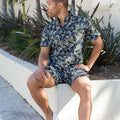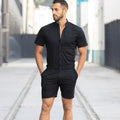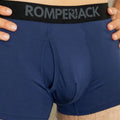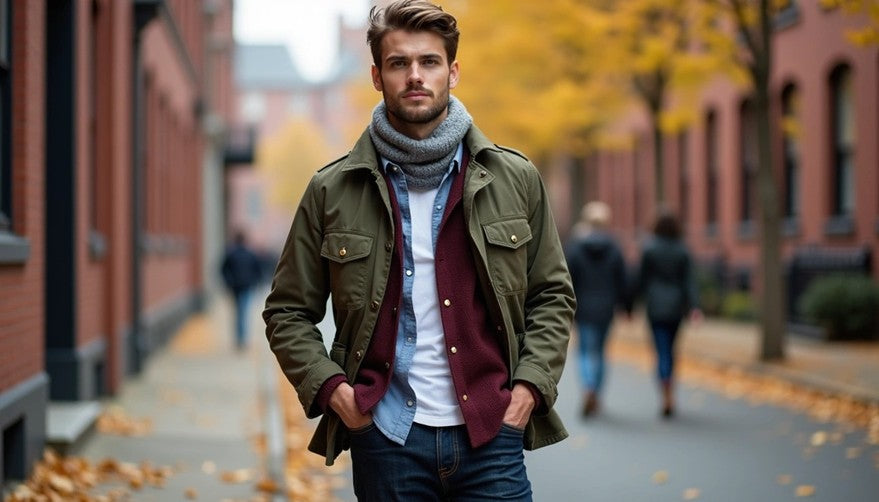Layering remains the secret to comfort and style during unpredictable weather seasons.
The art of layered outfits goes beyond simply stacking clothes—men need functional, fashionable looks that adapt to changing conditions. The base layer plays a crucial role in any fall outfit. This layer touches your skin directly and helps retain body heat while managing sweat.
Smart color choices form the foundation of successful outfit building for men's layered looks. Newcomers to fall layering should start with core colors. The season's palette draws inspiration from fall foliage—think deep reds, oranges, browns, and olive greens.
Men's layered outfits shine through their versatility. The right approach to layered clothing creates looks that blend practicality with style and comfort. This piece walks you through becoming skilled at layering—from selecting the perfect base layer to adding smart finishing touches that lift your look.
Start with the Right Base Layer
"In general, you want to wear lighter/thinner fabrics closer to your body, and heavier/thicker fabrics farther out." — Peter Manning, Founder, Peter Manning NYC (menswear brand specializing in fit and style)
A well-fitted base layer is the life-blood of any successful layered outfit. This first piece of clothing sits right against your skin and sets the foundation that your entire look builds upon.
Choose breathable fabrics like cotton or merino
Your base layer's material makes all the difference in how comfortable you'll feel all day. Breathability should be your top priority for men's layering outfits. Merino wool stands out as an excellent choice because it naturally keeps your body temperature balanced—you stay warm in cold weather and cool as temperatures climb. The material's antimicrobial properties make it great at fighting odors too.
Synthetic materials like polyester or nylon work great, especially when you have high-intensity activities planned. These fabrics pull moisture away from your body and dry much faster than other materials. They don't fight odors quite as well as merino though.
Many people think cotton works well, but it's not the best choice for base layers in fall layered outfits. It soaks up moisture like a sponge and takes forever to dry, which can leave you feeling chilly and uncomfortable.
Stick to neutral colors for versatility
The color you pick for your base layer matters more than most guys realize. Neutral shades—blacks, whites, grays, and navy blues—work with everything in your wardrobe.
These colors let you mix and match with any mid-layer or outerwear you own. You'll end up with more outfit options using fewer pieces. This works great for men's layered outfits where different layers might show at the neck, wrists, or when outer layers come off.
Fit matters: avoid bulky or loose base layers
Nothing ruins men's layering quite like a poorly fitted base layer. Your base layer should feel like a second skin that moves with your body. It needs to be snug but not restrictive.
Loose base layers miss the whole point—they can't wick moisture or keep you warm properly. A loose first layer also creates bulk and bunching when you add more layers, which ruins your outfit's clean lines.
The perfect base layer should stay tucked in and cover your wrists and lower back, even during stretches. This keeps cold air from sneaking in at these spots that people often forget about.
Build Warmth with Mid-Layers
Your 2-year-old base layer needs that vital middle element that men often skip in layered outfits. A mid-layer acts as your main insulation. It traps body heat and eliminates moisture.
Use flannels, hoodies, or lightweight sweaters
Mid-layers come in many forms, and each gives you distinct advantages for men's layering outfits. Flannel shirts are versatile options that give you remarkable warmth without bulk. A quality flannel pairs perfectly over a t-shirt or Henley to create casual fall layered outfits that blend comfort and style.
Lightweight sweaters made from merino wool or cashmere give you exceptional insulation while keeping a refined silhouette. These fine-gauge knits merge smoothly under jackets without bunching fabric or distorting your outerwear's lines.
Hoodies and sweatshirts are a great way to get comfort and practicality in men's layered outfits. Cotton-blend garments work best for weekend wear. They provide substantial warmth and maintain a casual look.
Mix textures for visual interest
Men's layered clothing needs thoughtful texture combinations to create depth. Here are some combinations off the top of my head:
· A smooth cotton base with a chunky shawl cardigan
· A textured Henley beneath a sleek vest and button-down
· A rugged denim shirt over a soft tee and under a knit sweater
Different fabric textures raise basic outfits into visually compelling ensembles. This layering approach works especially when you have refined pieces mixed with casual elements—like a preppy cashmere sweater under an edgy leather jacket.
Avoid layering similar weights together
Men's layered outfits follow one simple principle: start light and build up. Your mid-layer should fit slightly looser than your base layer, but keep a streamlined profile. You want warmth without unnecessary bulk.
Similar-weight fabrics paired together create a lumpy, unflattering silhouette. The solution is to progress from thinner fabrics closest to your body toward heavier pieces as you move outward. This graduated approach means each layer performs its job without limiting your movement or style.
Note that each layer should stand alone—your flannel or sweater should look good even if you take off your jacket later.
Top It Off with Functional Outerwear
"Layering with an overcoat can be adapted as a style option for a wide range of occasions, both semi-formal, business casual, and sometimes smart-casual looks." — Kobi Omenaka (Mr Koachman), Founder, Mr Koachman (men's style and grooming expert)
Selecting the right outerwear is the final piece of the layering puzzle. Your outer shell protects you from the elements and ends up defining your overall look.
Pick jackets that match your lifestyle
Your outerwear should match what you do each day. Puffer jackets filled with down or synthetic fibers are perfect for extreme cold. They create air pockets to trap body heat and provide excellent insulation. Wool or cashmere overcoats give you warmth and refinement - perfect for formal settings. Parkas with extended length and fur-lined hoods are great at protecting you from harsh winter conditions.
Balance warmth and mobility
A good jacket lets you move freely while keeping you warm. The fit matters - your outerwear needs room for mid-layers without limiting movement. It shouldn't be too large, or it will lose its insulating properties. Note that three is the magic number for total layers. Four layers usually make you look overstuffed.
Try shackets, vests, or quilted coats
Here are some versatile options to think about:
· Shackets: These shirt-jacket hybrids are heavier than a shirt but lighter than a coat - ideal for transitional weather.
· Vests: Sleeveless designs let your arms move freely while keeping your core warm. Technical fabric vests work well with classic outfits.
· Quilted coats: Their unique stitched pattern insulates without bulk, making them great for all-day wear.
Each piece should work on its own. Your outerwear needs to look good by itself when you remove layers.
Style Your Look with Smart Finishing Touches
Small details elevate good men's layered outfits to great ones. These finishing touches create the difference between looking thoughtfully dressed and just wearing clothes.
Add accessories like scarves or beanies
Accessories do more than decorate—they serve as functional elements that complete layered clothing for men. A carefully chosen scarf adds warmth and creates visual interest around your face. You can select scarves in colors that complement your outerwear to maximize versatility. Printed designs that incorporate your jacket's hues work well, too. Beanies provide significant head warmth (though not the mythical 80% heat loss) and boost your winter style.
Use one statement piece to anchor the outfit
Your men's layered outfits should revolve around one standout item that becomes your look's focal point. This could be a luxurious cashmere cardigan or distinctive corduroy pants. The secret lies in balancing this statement piece with simpler, complementary items. To achieve monochromatic layering, try different shades of one neutral color for a refined appearance.
Coordinate your pants and shoes with the top layers
A successful fall layered outfit needs harmony between upper and lower elements. Your leather belts should match your leather shoes. The pants' proportions must balance with your top layers.
Keep each layer functional on its own
Every component should look good independently. This practical approach means your men's layering works well, whatever the temperature changes throughout the day.
Conclusion
Becoming skilled at layering can turn your wardrobe from functional to versatile and stylish. This piece shows you how smart layering helps create outfits that adapt to temperature changes while you retain your personal style.
A great layered outfit starts with a breathable, well-fitted base layer against your skin. Mid-layers then add warmth and visual interest through varied textures. Your outerwear choice ties everything together and shields you from the elements while defining your look.
Color coordination makes the whole outfit work. Neutral base layers give you the most options, while carefully chosen color accents through accessories or statement pieces can lift simple combinations into eye-catching outfits.
Your layers should work well on their own. This practical mindset will keep you comfortable whatever the temperature. You'll be able to add or remove pieces as needed while looking put-together.
Layering's true power comes from its flexibility. A few quality pieces can create dozens of distinct outfits for different occasions and weather. Try different combinations, textures, and accessories to find your perfect style match.
These layering principles will help you handle changing seasons confidently and stylishly. Your clothes will serve you better by combining pieces thoughtfully instead of buying too much. Practice these techniques and layering will become natural – just part of getting dressed each day.
Key Takeaways
Master the art of layering to create versatile, stylish outfits that adapt to changing weather while maintaining comfort and functionality.
• Start with breathable, fitted base layers in neutral colors like merino wool or synthetic fabrics that wick moisture effectively • Build warmth with mid-layers like flannels or lightweight sweaters, mixing textures while avoiding similar-weight fabrics together • Choose outerwear that matches your lifestyle needs, balancing warmth and mobility with pieces like shackets, vests, or quilted coats • Add strategic accessories like scarves or beanies, using one statement piece to anchor your entire look • Ensure each layer functions independently so you can adapt to temperature changes throughout the day
The key to successful layering is progression from light to heavy fabrics, creating a system where every piece serves both a practical and aesthetic purpose. This approach maximizes your wardrobe's versatility while ensuring you look polished in any weather condition.
FAQs
Q1. What are the key principles for layering men's outfits? Start with a breathable base layer, add insulating mid-layers, and finish with functional outerwear. Progress from lighter to heavier fabrics, ensuring each layer serves both a practical and aesthetic purpose.
Q2. How can I create visual interest in layered outfits? Mix textures and fabrics to add depth to your look. For example, pair a smooth cotton base with a chunky cardigan, or layer a rugged denim shirt over a soft tee and under a knit sweater.
Q3. What are some versatile outerwear options for layered looks? Consider shackets (shirt-jacket hybrids), vests for core warmth, or quilted coats for insulation without bulk. Choose pieces that match your lifestyle and allow for a full range of motion.
Q4. How do I ensure my layered outfit doesn't look bulky? Avoid layering similar weights together and stick to the "rule of three" for total layers. Ensure each piece fits well, with base layers being snug and outer layers roomy enough to accommodate what's underneath without restricting movement.
Q5. What role do accessories play in layered outfits? Accessories like scarves and beanies add both style and functionality to layered looks. They can provide extra warmth, create visual interest, and serve as a statement piece to anchor your entire outfit.







